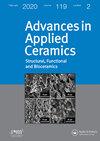前驱体法和微波烧结法制备高温活性硼化锆粉体
IF 1.6
4区 材料科学
Q3 MATERIALS SCIENCE, CERAMICS
引用次数: 1
摘要
摘要以8种C6H14O6 (ZrOCl2·8H2O)、硼酸(H3BO3)、柠檬酸(I)和甘露醇为原料,采用溶胶-凝胶法制备ZrB2粉体。结果表明:通过微波加热,ZrB2粉末的完全合成温度为1400℃,比传统方法低300℃;采用XRD和SEM对粉末的物相组成和形貌进行表征。此外,还考察了原料配比和合成温度对粉体合成的影响。温度对合成的硼化锆纯度有相当大的影响。用微波在1400℃下成功合成了高纯度近球形ZrB2超细粉体,C:Zr比为7.44:1,B:Zr比为2.77:1。本文章由计算机程序翻译,如有差异,请以英文原文为准。
Preparation of high-temperature active zirconium boride powders via precursor route and microwave sintering
ABSTRACT ZrB2 powders were synthesised by microwave heating using the sol–gel method for precursor with eight C6H14O6 (ZrOCl2·8H2O), boric acid (H3BO3), citric acid (I), and mannitol (as raw materials). The results show that the temperature at which the ZrB2 powder is completely synthesised by microwave heating is 1400°C, which is 300°C lower than the traditional way. XRD and SEM were used to characterise the phase composition and morphology of the powders. In addition, the effects of raw material ratios and synthesis temperature on the synthesis of powder were investigated. The effect of temperature on the purity of the synthesised zirconium boride was considerable. The nearly spherical ZrB2 ultra-fine powders of high purity were synthesised successfully at 1400°C by microwave, with the ratios of C:Zr is 7.44:1, and B:Zr is 2.77:1.
求助全文
通过发布文献求助,成功后即可免费获取论文全文。
去求助
来源期刊

Advances in Applied Ceramics
工程技术-材料科学:硅酸盐
CiteScore
4.40
自引率
4.50%
发文量
17
审稿时长
5.2 months
期刊介绍:
Advances in Applied Ceramics: Structural, Functional and Bioceramics provides international coverage of high-quality research on functional ceramics, engineering ceramics and bioceramics.
 求助内容:
求助内容: 应助结果提醒方式:
应助结果提醒方式:


